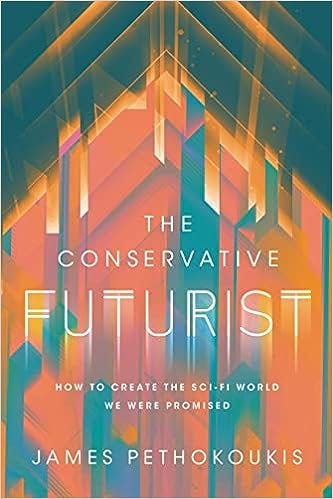⤴ Could AI really generate explosive economic growth?
A new study estimates explosive AI-driven growth this century "about as likely as not." I'll take it!
Quote of the Issue
"The universe is a pretty big place. It's bigger than anything anyone has ever dreamed of before. So if it's just us ... seems like an awful waste of space." - “Ellie Arroway,” Contact
Some self promotion: I have a book coming out on October 3. The Conservative Futurist: How To Create the Sci-Fi World We Were Promised is currently available for pre-order pretty much everywhere. Some folks are already saying nice things about it:
Anyway, I’m very excited about it! Let’s gooooo! 🆙↗⤴📈
The Essay
⤴ Could AI really generate explosive economic growth?
➡ Super-short Summary: A new analysis examines the case for artificial general intelligence, or AGI, enabling explosive economic growth this century. Good news: Growth could accelerate sharply if AI makes human labor accumulable and scalable like capital. Even basic simulations show massive expansion potential if AI systems are inexpensive. Even one-time productivity surges seem plausible from partial automation. However, potential barriers include regulations, physical bottlenecks, gradual adoption, misalignment risks, innovation challenges, and measurement issues. While each concern has some validity, individually most seem surmountable. After weighing each counterargument's limitations, as well as AI's unprecedented automation potential, explosive growth appears a substantial possibility, not a remote one. Yeah!
What happens if radio astronomers detect a ping — followed by a string of prime numbers, of course — from an alien civilization? I love it when such a scenario is depicted in sci-fi, such as in the 1997 film Contact. Scientists rushing around like firefighters when an alarm sounds. Maybe a dramatic “Someone call the White House!”
But from what I gather, there’s no specific protocol about what to do next, though verifying the discovery with other scientists would probably be the most likely first step. But eventually, I would assume, there would be a presidential announcement. The closest we’ve come so far is President Bill Clinton’s brief statement back in 1996 after NASA announced a primitive form of microscopic life may have existed on Mars about 4 billion years ago based on its examination of an ancient Martian meteorite found in Antarctica in 1984. (Video of Clinton was used a year later in Contact, edited to make it seem as if Clinton was talking about the alien message in the film. Reportedly, Clinton was quite annoyed.)
It’s anyone's guess if an American president will ever need to announce the discovery of alien life or intelligence. But if the superforecasters at Metaculus, the online prediction platform, are correct, the next American president will have the opportunity to announce an alien intelligence of a different sort: artificial general intelligence, or AGI. The consensus community prediction sees sAGI by September 2030 and “weak” AGI by 2027. (Metaculus has specific criteria for both, but a stronger AGI would be capable of exhibiting a broad set of high-level competencies in both communication and practical tasks of the sort that typically require human-level intelligence or beyond.)
It is strong, or at least pretty strong, AGI that’s the entity discussed in the new paper “Explosive Growth from AI Automation: A Review of the Arguments” by researchers Ege Erdil (Epoch) and Tamay Besiroglu (Epoch, MITFutureTech). Erdil and Besiroglu describe the technology as “capable of substantially automating economically valuable tasks.” And by “explosive growth,” they mean “growth an order of magnitude greater than what is typical in today’s frontier economies. Specifically, we define this as annual real gross world product (GWP) exceeding 130% of its maximum value over all previous years.”
The good news on AI and explosive growth
Erdil and Besiroglu then examine three key arguments in favor of Explosive Growth.
Standard economic growth models predict economies will zoom upward when factors of production become “accumulable,” meaning they can be expanded through additional investment. If AI systems can substantially substitute for human labor, the total stock of labor becomes accumulating, not fixed. More output enables more AI worker investment, enabling yet greater output in a positive feedback loop. A flywheel of progress. “Hence, such models generically predict super-exponential growth conditional on AI that suitably substitutes for human labor,” Erdil and Besiroglu write. (A similar statement can be found in a 2014 paper written for the San Francisco Fed by economists John Fernald and Charles Jones: “If capital can replace labor entirely, growth rates could explode, with incomes becoming infinite in finite time.”)
Even a simple economic growth model shows that AI systems substituting for human workers could expand the economy massively if certain conditions are met. Imagine a model that assumes the economy invests in two kinds of "workers" — human laborers and AI systems. It shows that if the cost of an AI system doing the work of a human is low enough — and enough is invested in AI systems — then the "stock" of AI workers could grow extremely fast “and give rise to explosive growth.” Erdil and Besiroglu estimate that if an AI system costs less than $15,000 per year to do the work of one human (the dollar figure comes from estimating the computational requirements of the human brain and the current cost of computation) and at least 20 percent of the economy is invested rather than consumed, the model predicts over 30 percent yearly growth.
Oh, and this estimate doesn’t account for big improvements in both hardware and software. Erdil and Besiroglu: “Therefore, the argument presented in the analysis becomes more persuasive if one anticipates that AGI will take around 10 to 20 years to develop, a period during which computer hardware could become one or two orders of magnitude more cost-effective. This dynamic could potentially amplify the economic growth impact of labor substitution by AI.”
There is an important difference in economic growth theory between growth effects and level effects. A growth effect is some change that leads to higher long-term growth, like increased R&D spending or effective education investment. A level effect is a one-time boost that doesn't increase future growth, such as stimulus spending. Even if AI doesn't create a permanent growth effect, deploying human-level AI could still produce a substantial transitory-level effect. Maybe not all worker tasks could be automated. Yet even so, rapidly deploying a pretty good AI system could temporarily boost growth rates to explosive levels. Erdil and Besiroglu: “This argument suggests that explosive growth remains possible even if AI does not result in full automation and even if humans continue to occupy roles in the economy that bottleneck production. As such, it’s a ‘worst case argument’ which leads us to put some probability on explosive growth even in such worlds.”
The bad news on AI and explosive growth
Now even though the researchers concede that they “have become more partial towards the idea that explosive growth looks highly plausible, likely more so than informal polls suggest economists are,” they offer lots of counterarguments against Explosive Growth:
Keep reading with a 7-day free trial
Subscribe to Faster, Please! to keep reading this post and get 7 days of free access to the full post archives.





